2018 MERCEDES-BENZ CLA COUPE warning
[x] Cancel search: warningPage 58 of 326
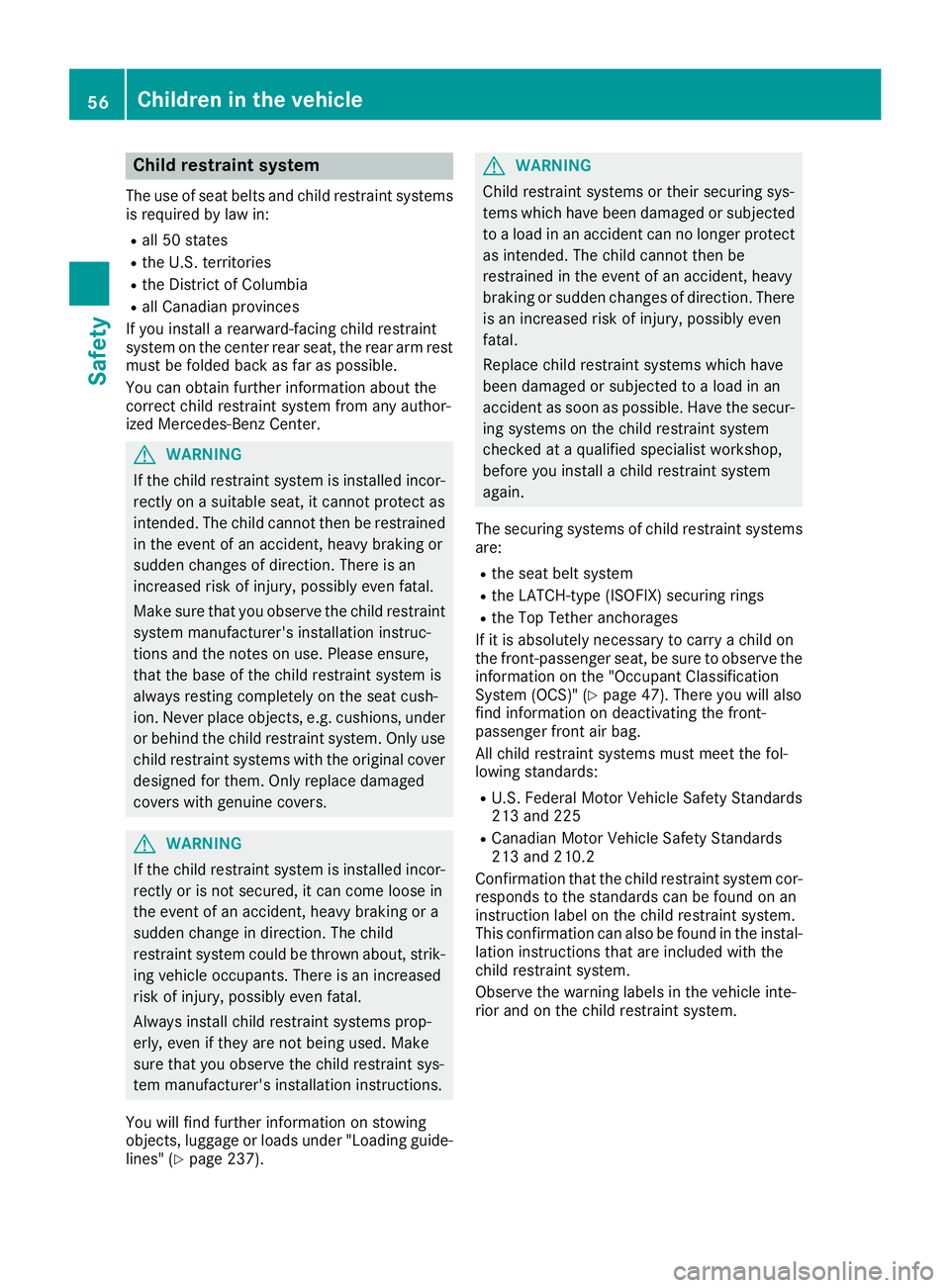
Child restraint system
The use of seat beltsand child restraint systems
is required by law in:
Rall 50 states
Rth eU .S.t erri tories
RtheD istrict of Columbia
Rall Canadian provinces
If you install arearward-facing child restraint
system on th ecente rrear seat,t herear arm rest
must be folded back as far as possible.
You can obtain further informatio nabout the
correc tchild restraint system from any author-
ize dM ercedes-Ben zCenter.
GWARNING
If th echild restraint system is installed incor-
rectly on asuitable seat,itc annotprotect as
intended. The child canno tthe nber estrained
in th eevent of an accident, heavyb raking or
suddenc hanges of direction.T hereisan
increased ris kofinjury, possibly eve nfatal.
Makes ure that you observ ethe child restraint
system manufacturer'si nstallationinstruc-
tions and th enotes on use. Pleasee nsure,
that th ebase of th echild restraint system is
always restin gcompletely on th eseat cush-
ion.N ever placeo bjects, e.g.cushions, under
or behindt hechild restraint system. Only use
child restraint systems witht heoriginal cover
designe dfor them. Only replace damaged
covers withg enuine covers.
GWARNING
If th echild restraint system is installed incor-
rectly or is no tsecured, it can com eloosei n
th ee vent of an accident, heavyb raking or a
suddenc hang eind irection.T he child
restraint system coul dbethrown about,s trik-
ing vehicle occupants. Thereisani ncreased
ris kofi njury, possibly eve nfatal.
Always install child restraint systems prop-
erly, eve niftheya re no tbeingu sed. Make
sure that you observ ethe child restraint sys-
te mm anufacturer'si nstallationinstructions.
You will fin dfurther informatio nonstowing
objects, luggageorl oads under"Loading guide-
lines" (
Ypage 237).
GWARNING
Child restraint systems or their securin gsys-
tems whichh ave been damaged or subjected
to aload in an accidentc an no longer protect
as intended. The child canno tthe nb e
restraine dintheevent of an accident, heavy
braking or suddenc hanges of direction.T here
is an increased ris kofinjury, possibly even
fatal.
Replacec hild restraint systems whichh ave
been damaged or subjected to aload in an
accidentass oon as possible. Hav ethe secur-
ing systems on th echild restraint system
checked at aqualified specialist workshop,
before you install achild restraint system
again.
The securin gsystems of child restraint systems
are:
Rth es eat belt system
RtheL ATCH-type (ISOFIX) securin grings
RtheT op Tether anchorages
If it is absolutely necessary to carry achild on
th ef ront-pa ssenger seat,bes ure to observethe
informatio nonthe"Occupan tClassification
Syste m(OCS)" (
Ypage 47) .Therey ou will also
fin dinformatio nondeactivatin gthe front-
passenger fronta ir bag.
All child restraint systems must mee tthe fol-
lowings tandards:
RU.S. Federal Motor Vehicle SafetyS tandards
21 3a nd 225
RCanadian Motor Vehicle SafetyS tandards
21 3a nd 210.2
Confirmation that th echild restraint system cor-
responds to th estandards can be foun donan
ins truc
tion label on th
echild restraint system.
This confirmation can also be foun dintheinstal-
lation instructionst hata re included witht he
child restraint system.
Observ ethe warning labels in th evehicle inte-
rior and on th echild restraint system.
56Children in th evehicle
Safety
Page 59 of 326
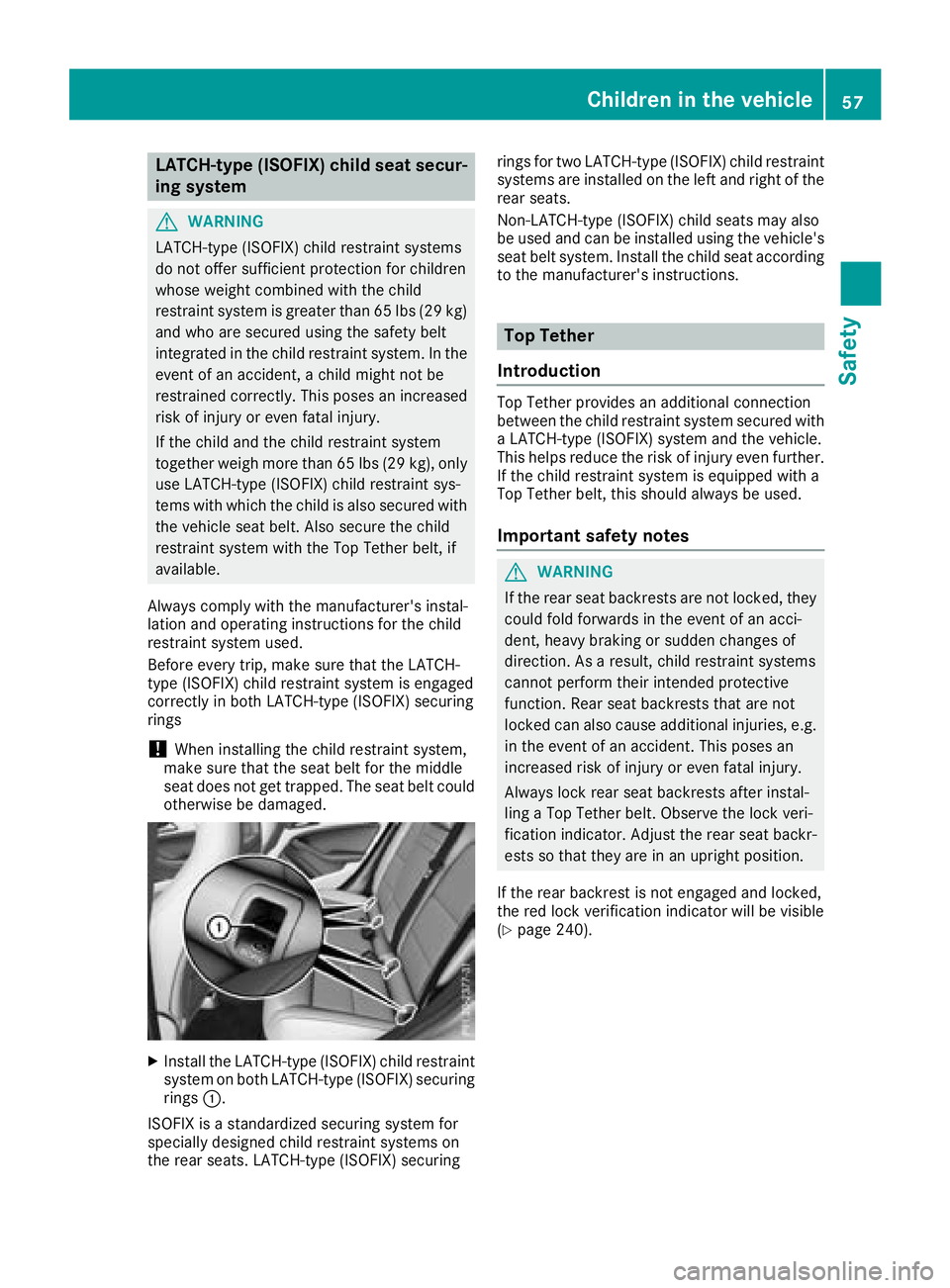
LATCH-type(ISOFIX) child seat secur-
ing system
GWARNING
LATCH-type (ISOFIX) child restraint systems
do not offer sufficient protection for children
whose weight combine dwith th echild
restraint system is greater than 65 lbs (29 kg) and who are secured usingt hesafety belt
integrated in th echild restraint system. In the
even tofana ccident, achild mightn ot be
restrained correctly. This poses an increased
risk of injury or even fatal injury.
If th echild and th echild restraint system
together weigh moret han65l bs (29 kg), only
use LATCH-type (ISOFIX) child restraint sys-
tem swith whicht hechild is also secured with
th ev ehicle seat belt.A lsos ecure th echild
restraint system with th eTop Tether belt,i f
available.
Always comply with th emanufacturer' sinstal-
latio nand operatin ginstructionsf or thechild
restraint system used.
Before ever ytrip, makes ure that th eLATCH-
type (ISOFIX) child restraint system is engaged
correctly in bothL ATCH-type (ISOFIX) securing
rings
!When installing th echild restraint system,
makes ure that th eseat belt for th emiddle
seat does not get trapped. The seat belt could otherwise be damaged.
XInstall th eLATCH-type (ISOFIX) child restraint
system on bothL ATCH-type (ISOFIX) securing
rings :.
ISOFI Xisas tandardized securings ystem for
specially designed child restraint systems on
th er ear seats. LATCH-type (ISOFIX) securing rings for two LATCH-type (ISOFIX) child restraint
systems are installe
dontheleft and rightoft he
rear seats.
Non-LATCH-type (ISOFIX) child seatsm ay also
be used and can be installe dusingt hevehicle's
seat belt system. Install th echild seat according
to th emanufacturer' sinstructions.
Top Tether
Introduction
Top Tether provides an additional connection
between th echild restraint system secured with
aL ATCH-type (ISOFIX) system and th evehicle.
This helps reducet herisk of injury even further.
If th echild restraint system is equipped with a
Top Tether belt,t hiss hould always be used.
Important safety notes
GWARNING
If th erear seat backrests are not locked ,the y
could fold forwards in th eeventofana cci-
dent, heavy braking or sudden changes of
direction. As aresult, child restraint systems
cannot perform their intended protective
function.R ear seat backrests that are not
locked can also cause additional injuries,e .g.
in th eeventofana ccident. This poses an
increased risk of injury or even fatal injury.
Always lock rear seat backrests after instal-
ling aTop Tether belt.O bserve thelockv eri-
ficatio nindicator. Adjust th erear seat backr-
estssot hatthe ya re in an uprightp osition.
If th erear backrestisn ot engaged and locked,
th er ed lock verificatio nindicator will be visible
(
Ypage 240).
Children in th evehicle57
Safety
Z
Page 61 of 326
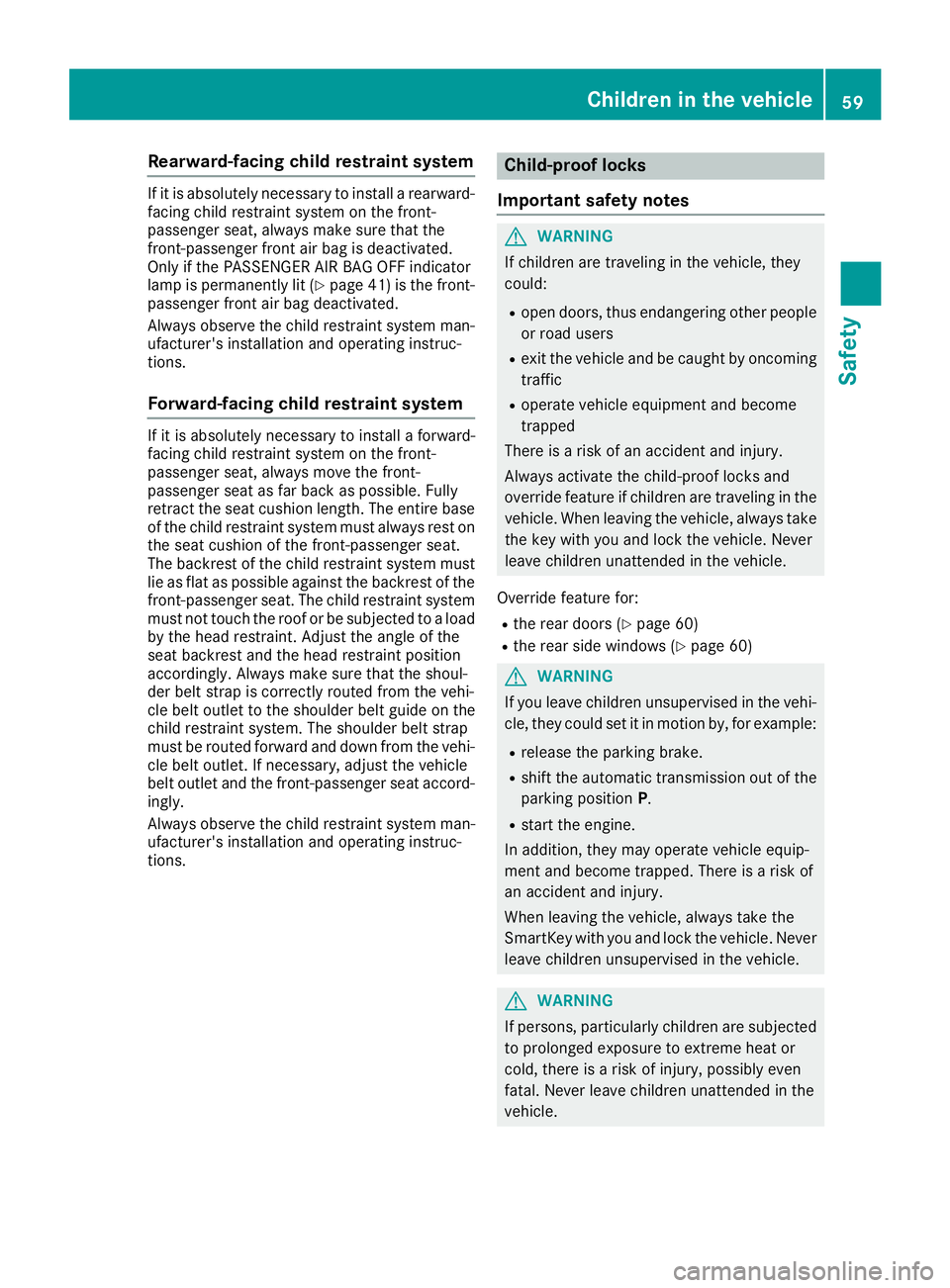
Rearward-facingchild restraint system
If it is absolutely necessary to install arearward-
facing child restraint system on the front-
passenger seat, always make sure that the
front-passenger front ai rbag is deactivated.
Only if the PASSENGER AIR BAG OFF indicator
lamp is permanently li t(
Ypage 41)ist he front-
passenger front ai rbag deactivated.
Alway sobserve the child restraint system man-
ufacturer's installation and operating instruc-
tions.
Forward-facing child restraint system
If it is absolutely necessary to install aforward-
facing child restraint system on the front-
passenger seat, always move the front-
passenger seata sfar back as possible .Fully
retract the seatc ushionlen gth. The entir ebase
of the child restraint system mus talway sresto n
the seatc ushionofthe front-passenger seat.
The backrest of the child restraint system must
li easf lata sp ossible against the backrest of the
front-passenger seat. The child restraint system
mus tnot touch the rooforbes ubjecte dtoal oad
by the headr estraint. Adjust the angle of the
seatb ackrest and the headr estraint position
accordingly .Alway smake sure that the shoul-
der bel tstrapisc orrectly routed from the vehi-
cle bel toutlet to the shoulder bel tguide on the
child restraint system. The shoulder bel tstrap
mus tberouted forward and dow nfrom the vehi-
cle bel toutlet. If necessary, adjust the vehicle
bel toutlet and the front-passenger seata ccord-
ingly.
Alway sobserve the child restraint system man-
ufacturer's installation and operating instruc-
tions.
Child-proof locks
Important safety notes
GWARNING
If children are traveling in the vehicle, they
could:
Rope ndoors, thuse ndangering otherp eople
or roadu sers
Rexitt he vehicl eand be caught by oncoming
traffic
Roperate vehicl eequipment and become
trapped
There is ariskofana ccident and injury.
Alway sactivate the child-proof locks and
overrid efeature if children are traveling in the
vehicle. Whenl eaving the vehicle, always take
the key with yo uand lock the vehicle. Never
leave children unattende dinthe vehicle.
Overrid efeature for:
Rthe reard oors (Ypage 60)
Rthe rearsidew indow s(Ypage 60)
GWARNING
If yo ulea ve children unsupervised in the vehi-
cle ,they could set it in motion by ,for example:
Rrelease the parking brake.
Rshift the automatic transmissio noutof the
parking position P.
Rstartthe engine.
In addition, they may operate vehicl eequip-
ment and become trapped .There is arisko f
an accident and injury.
Whenl eaving the vehicle, always take the
SmartKey with yo uand lock the vehicle. Never
leave children unsupervised in the vehicle.
GWARNING
If persons,p articularly children are subjected
to prolonged exposure to extreme heato r
cold, there is ariskofi njury, possibly even
fatal. Neverl eave children unattende dinthe
vehicle.
Childrenint he vehicle59
Safety
Z
Page 62 of 326

GWARNING
If the child restraint system is subjected to
direct sunlight, parts may get very hot. Chil-
dren may burn themselves on these parts,
particularl yonthe metal parts of the child
restraint system. There is arisk of injury.
If you leave the vehicle, taking the child with
you ,alway sensure that the child restraint
system is not exposedtod irect sunlight. Pro-
tect it with ablanket, for example. If the child
restraint system has been exposedtod irect
sunlight, let it cool downb efore securing the
child in it. Never leave children unattended in
the vehicle.
Child-proof locks for the rear doors
You secure each door individually with the child-
proof locks on the rear doors. Adoor secured
with achild-proof lock cannot be opened from
insid ethe vehicle. When the vehicleisu nlocked,
the door can be opened from the outside.
XTo activate: press the child-proof lock lever
up in the direction of arrow :.
XMake sure that the child-proof locks are work-
ing properly.
XTo deactivate: press the child-proof lock
leverd ownint he direction of arrow ;.
Override feature for the rear side win-
dows
XTo activate/deactivate: press button:.
If indicator lamp ;is lit, operation of the rear
side windows is disabled. Operation is only
possible using the switches in the driver's
door. If indicator lamp ;is off, operation is
possible using the switches in the rear com-
partment.
Pets in the vehicle
GWARNING
If you leave animals unattended or unsecured
in the vehicle, they coul dpress buttons or
switches, for example.
As aresult, they could:
Ractivate vehiclee quipment and become
trapped, for example
Ractivate or deactivate systems ,thereby
endangering other road users
Unsecure danimals coul dalsobef lung around
the vehicleint he event of an accident or sud-
den steering or braking, thereby injuring vehi-
cle occupants. There is arisk of an accident
and injury.
Never leave animals unattended in the vehi-
cle. Always secure animals properly during
the journey ,e.g. use asuitable anima ltrans-
port box.
60Pets in the vehicle
Safety
Page 63 of 326

Drivingsafet ys ystems
Overview of drivin gsafet ys ystems
In this section ,you will fin dinformati on about
th ef ollowin gdrivin gsafet ysystems :
RABS(Anti-lock Brakin gSystem)
(Ypage 61)
RBA S(Brak eAssist System) (Ypage 61)
RActive Brak eAssist(Ypage 62 )
RESP®(Electronic Stability Program)
(Ypage 64)
REB D( Electroni cBrak eforce Distribution )
(Ypage 67 )
RADAPTIV EBRAKE (Ypage 68 )
RSTEERCONTROL (Ypage 68)
Important safet ynotes
If you fail to adapt your drivin gstyle or if you are
inattentive ,the drivin gsafet ysystems can nei-
ther reduce th eriskofana ccidentnor override
th el aws of physics. Driving safet ysystems are
merely aids designed to assist driving. You are
responsible fo rmaintainin gthe distanc etothe
vehicle in front, fo rvehicle speed, fo rbraking in
goo dtime, and fo rstayin ginl ane. Always adapt
your drivin gstyle to suit th eprevailin groada nd
weather condition sand maintain asafed istanc e
from th evehicle in front. Drive carefully.
The drivin gsafet ysystems described only wor k
as effectively as possible when there is ade-
quat econtac tbetween th etires and th eroad
surface. Please pay special attention to th e
note sont ires ,recommended minimum tire
tread depths, etc. (
Ypage 288).
In wintr ydrivin gconditi ons, always use winte r
tires (M+ Stires )a nd if necessary,s now chains.
Onlyint hiswaywill the driving safety systems
describe dinthissection work as effectively as
possible.
ABS (Anti-lock Brakin gSystem)
General information
ABS regulate sbrake pressure in such awaythat
the wheels do not lock when yo ubrake. This
allows yo utocontinue steering the vehicl ewhen
braking. The
! ABS warning lamp in the instrument
cluster lights up when the ignition is switched
on. It goe soutwhen the engine is running.
ABS works from aspeed of about5m ph
(8 km/h), regardless of road-surface conditions.
ABS works on slippery surfaces, eve nwheny ou
onlyb rake gently.
Important safety notes
iObserve the "Important safety notes "sec-
tio n(Ypage 61).
GWARNING
If ABS is faulty ,the wheels could lock when
braking .The steerability and braking charac-
teristic smaybe severely impaired.A ddition-
ally ,further driving safety systemsa re deac-
tivated.T here is an increased danger of skid-
ding and accidents.
Driv eonc arefully. Hav eABS checked imme-
diately at aquali fied specialist workshop.
Whe nABS is malfunctioning ,othe rsystems,
including driving safety systems, will also
become inoperative. Observe the information
on the ABS warning lamp (
Ypage 220 )and dis-
play messages which maybes hown in the
instrument cluster (
Ypage 192).
Braking
XIf ABS intervenes: continue to depress the
brake peda lvigorously unti lthe braking sit-
uatio niso ver.
XTo make afullb rake application: depress
the brake peda lwithf ullf orce.
If ABS intervene swhenb raking ,you will fee la
pulsing in the brake pedal.
The pulsating brake peda lcan be an indication
of hazardousr oadconditions, and functions as a
reminder to take extra car ewhile driving.
BAS (Brak eAssis tSystem)
General information
BAS operates in emergency braking situations.
If yo udepress the brake peda lquickly, BAS
automaticall yboosts the braking force,t hus
shortening the stopping distance.
Driving safety systems61
Safety
Z
Page 64 of 326
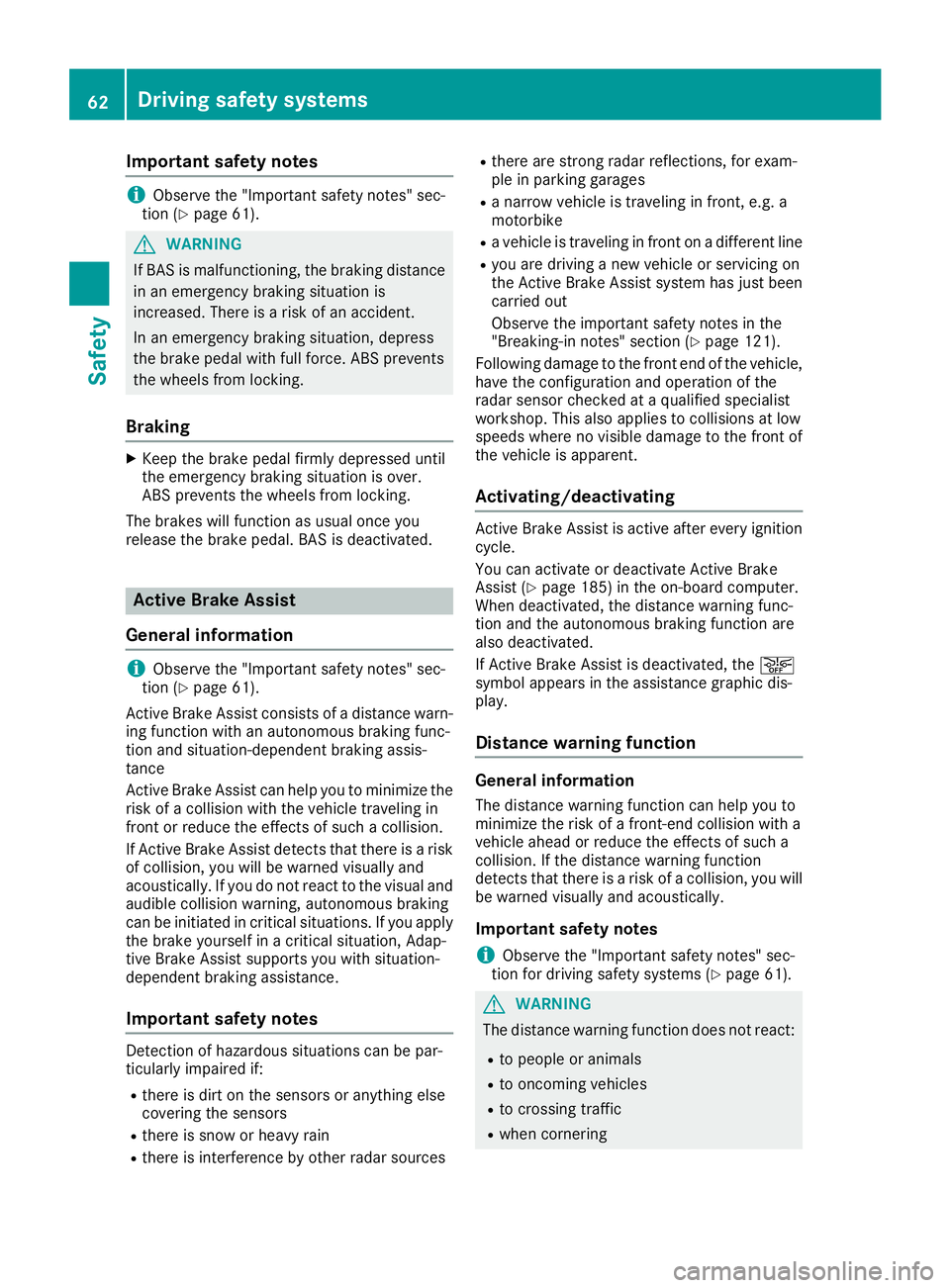
Important safety notes
iObservethe "Importan tsafet ynotes "sec-
tion (Ypage 61).
GWARNIN G
If BA Sism alfunctioning ,the braking distanc e
in an emergenc ybraking situation is
increased. Ther eisariskofana ccident.
In an emergenc ybraking situation ,depress
th eb rak epedal wit hfull force .ABS prevents
th ew heels from locking.
Braking
XKee pthe brak epedal firmly depressed until
th ee mergenc ybraking situation is over.
AB Sp revents th ewheels from locking.
The brakes will function as usual once you
release th ebrak epedal .BAS is deactivated.
Active Brak eAssist
General information
iObserv ethe "Importan tsafet ynotes "sec-
tion (Ypage 61).
Active Brake Assist consist sofadistancewarn-
ing function wit hanautonomous braking func-
tion and situation-dependen tbraking assis-
tance
Active Brake Assist can help you to minimiz ethe
ris kofac ollision wit hthe vehicl etraveling in
fron torr educe th eeffects of suc hacollision .
If Active Brake Assist detects that there is arisk
of collision ,you will be warned visually and
acoustically. If you do no treac ttot hevisual and
audible collision warning ,autonomous braking
can be initiate dincritical situations. If you apply
th eb rak eyourself in acritical situation ,Adap-
tive Brake Assist support syou wit hsituation -
dependen tbraking assistance.
Important safety notes
Detection of hazardous situation scan be par-
ticularly impaired if:
Rthere is dirt on th esensor soranythin gelse
covering th esensor s
Rthere is snow or heav yrain
Rthere is interferenc ebyother radar source s
Rthere are strongradar reflections, for exam-
ple in parking garages
Ran arrow vehicl eistraveling in front, e.g. a
motorbike
Rav ehicl eistraveling in fron tonadifferentlin e
Ryou are driving anew vehicl eorservicing on
th eA ctiv eBrake Assist system has jus tbeen
carrie dout
Observ ethe important safet ynotes in the
"Breaking-in notes" section (
Ypage 121).
Followin gdamag etothefron tend of th evehicle,
hav ethe configuration and operation of th e
radar sensor checke dataqualified specialist
workshop. This also applie stocollision satlow
speeds wher enovisible damag etothefron tof
th ev ehicl eisa pparent.
Activating/deactivating
Active Brake Assist is active after every ignition
cycle.
You can activat eordeactivat eActiv eBrake
Assist (
Ypage 185) in th eon-bo ard computer.
When deactivated, th edistanc ewarning func-
tion and th eautonomous braking function are
also deactivated.
If Active Brake Assist is deactivated, th eæ
symbol appear sintheassistanc egraphic dis-
play.
Distance warning function
Gene ralinformation
The distanc ewarning function can help you to
minimiz ethe riskofaf ront-end collision wit ha
vehicl eahead or reduce th eeffects of suc ha
collision .Ifthedistanc ewarning function
detects that there is ariskofac ollision ,you will
be warned visually and acoustically.
Imp ortant safety notes
iObserv ethe "Importan tsafet ynotes "sec-
tion for driving safet ysystems (Ypage 61).
GWARNIN G
The distanc ewarning function does no treact:
Rto people or animals
Rto oncomin gvehicles
Rto crossing traffic
Rwhen cornering
62Driving safety systems
Safety
Page 65 of 326
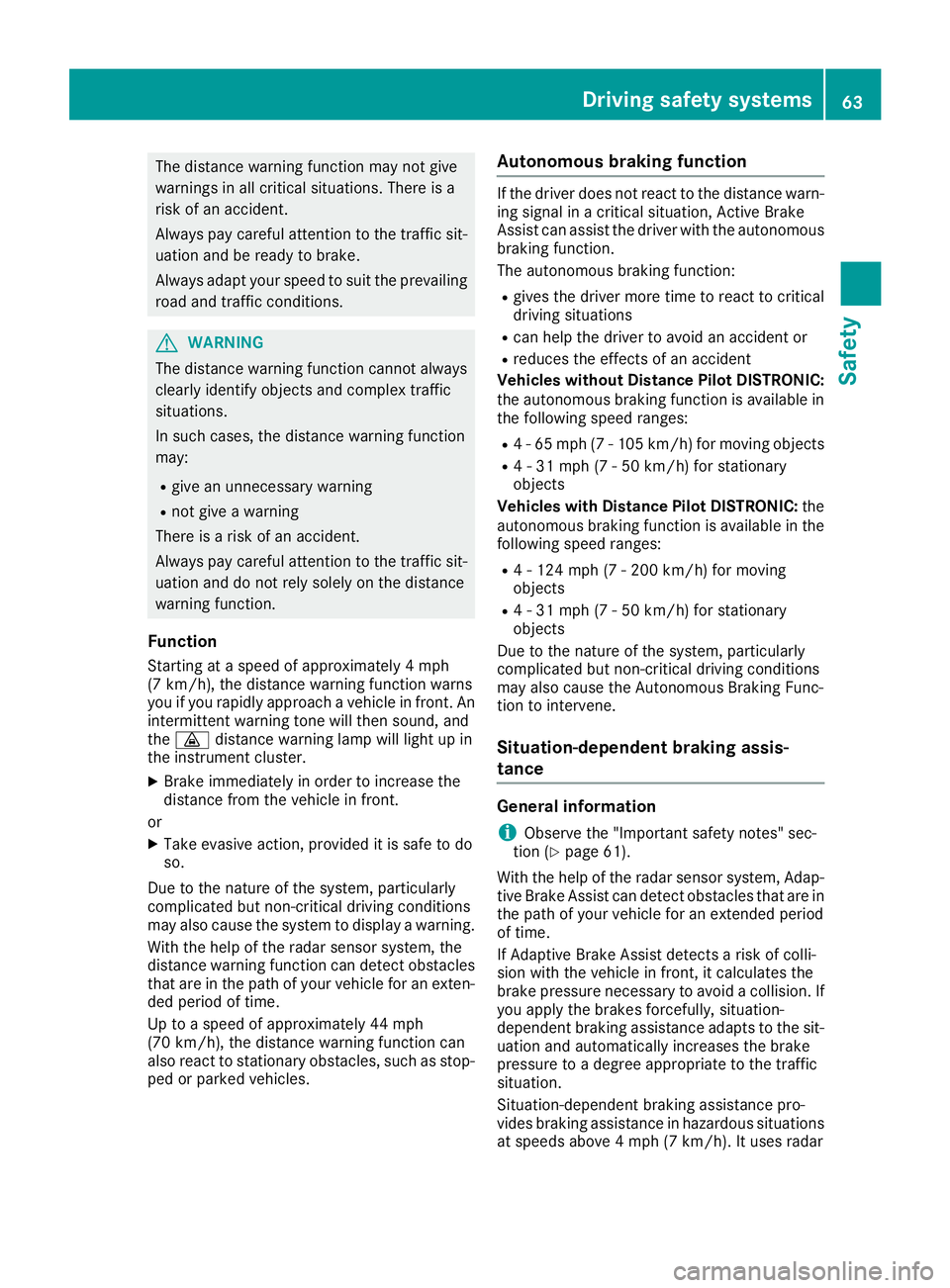
The distance warning function may not give
warnings in all critical situations. There is a
risk of an accident.
Always pay careful attention to the traffic sit-uation and be ready to brake.
Always adapt your speed to suit the prevailing
road and traffic conditions.
GWARNING
The distance warning function cannot always
clearly identify object sand complex traffic
situations.
In such cases, the distance warning function
may:
Rgive an unnecessary warning
Rnot give awarning
There is arisk of an accident.
Always pay careful attention to the traffic sit-
uation and do not rely solely on the distance
warning function.
Function
Starting at aspeed of approximately 4mph
(7 km/h), the distance warning function warns
you if you rapidly approach avehicle in front.A n
intermittent warning ton ewill then sound, and
the · distance warning lamp will light up in
the instrument cluster.
XBrake immediately in order to increase the
distance from the vehicle in front.
or
XTake evasive action, provided it is safe to do
so.
Due to the nature of the system, particularly
complicated but non-critical driving conditions
may also cause the system to display awarning.
With the help of the radar sensor system, the
distance warning function can detect obstacles
that are in the path of your vehicle for an exten-
ded period of time.
Up to aspeed of approximately 44 mph
(70 km/h), the distance warning function can
also react to stationary obstacles, such as stop-
ped or parked vehicles.
Autonomous braking function
If the driver does not react to the distance warn-
ing signal in acritical situation, Active Brake
Assist can assist the driver with the autonomous
braking function.
The autonomous braking function:
Rgives the driver more time to react to critical
driving situations
Rcan help the driver to avoid an accident or
Rreduces the effectsofana ccident
Vehicles without Distance Pilot DISTRONIC: the autonomous braking function is available in
the following speed ranges:
R4-65m ph (7-105 km/h) for moving objects
R4-31mph (7-50km/h)for stationary
objects
Vehicles with Distance Pilot DISTRONIC: the
autonomous braking function is available in the
following speedr anges:
R4-124 mph (7 -200 km/h )for moving
objects
R4-31m ph (7-50km/h)for stationary
objects
Due to the nature of the system ,particularly
complicated but non-critical driving conditions
may als ocaus ethe Autonomou sBraking Func-
tion to intervene.
Situation-dependent braking assis-
tance
General information
iObservet he "Important safety notes" sec-
tion (Ypag e61).
With the help of the rada rsensor system ,Adap-
tive Brake Assist can detect obstacles that are in
the path of you rvehiclef or an extended period
of time.
If Adaptive Brake Assist detects arisk of colli-
sion with the vehicleinf ront, it calculatesthe
brake pressure necessary to avoi dacollision. If
you apply the brakes forcefully ,situation-
dependent braking assistance adapts to the sit-
uation and automatically increases the brake
pressure to adegreea ppropriate to the traffic
situation.
Situation-dependent braking assistance pro-
videsb raking assistance in hazardou ssituations
at speeds above 4mph (7 km/h) .Itusesr adar
Driving safety systems63
Safety
Z
Page 66 of 326
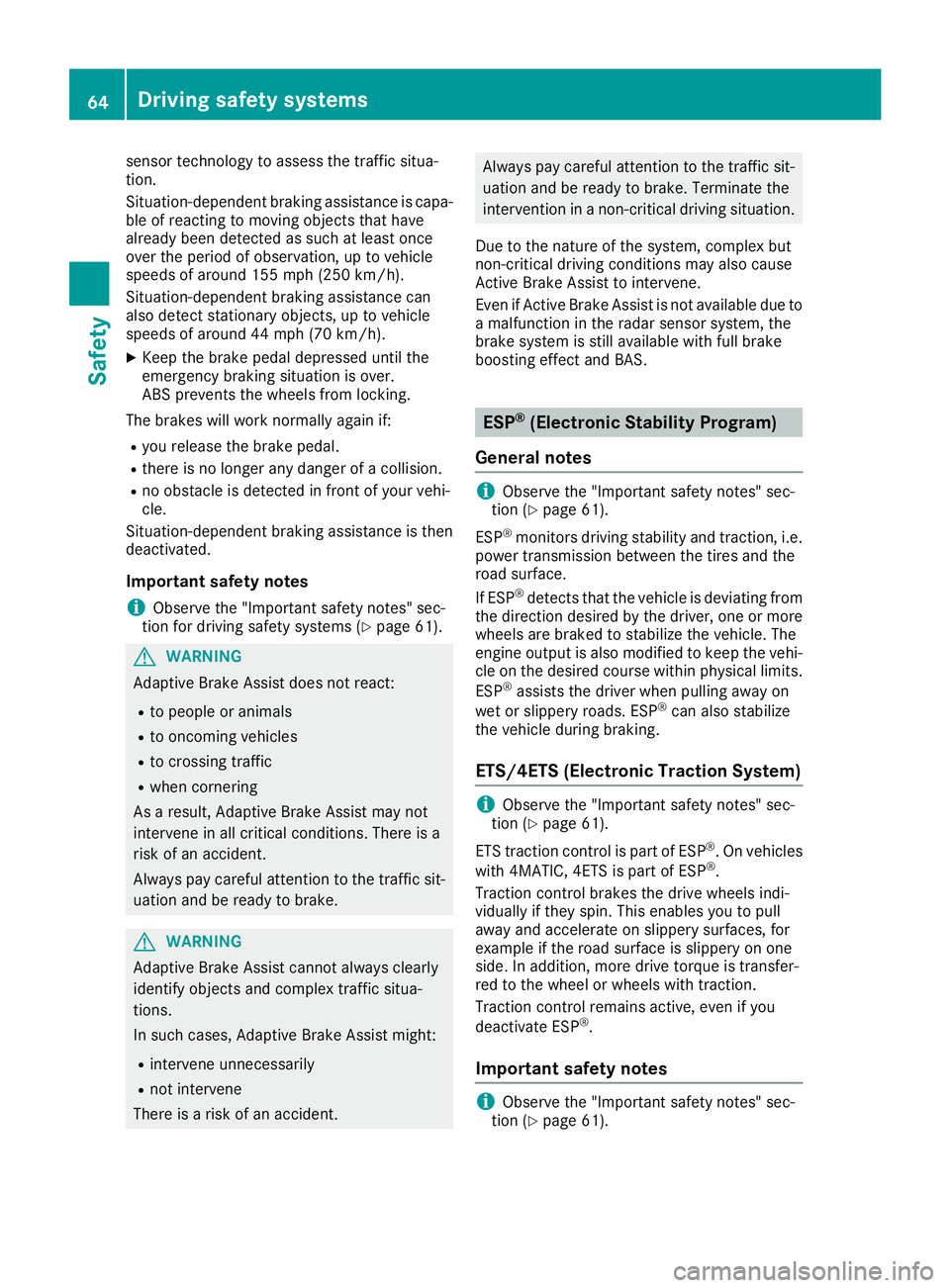
sensor technology to assess the traffic situa-
tion.
Situation-dependent braking assistance is capa-
ble of reacting to moving objects that have
alreadybeen detected as such at least once
over the period of observation, up to vehicle
speeds of around 155 mph (250 km/h).
Situation-dependent braking assistance can
also detect stationary objects, up to vehicle
speeds of around 44 mph (70 km/h).
XKeep the brake pedal depressed until the
emergency braking situation is over.
ABS prevents the wheels from locking.
The brakes will work normally againi f:
Ryou release the brake pedal.
Rthere is no longer any danger ofacollision.
Rno obstacle is detected in front of your vehi-
cle.
Situation-dependent braking assistance is then
deactivated.
Important safety notes
iObserve the "Important safety notes" sec-
tion for driving safety systems (Ypage 61).
GWARNING
Adaptive Brake Assist does not react:
Rto people or animals
Rto oncoming vehicles
Rto crossing traffic
Rwhen cornering
As aresult, Adaptive Brake Assist may not
intervene in all critical conditions. There is a
risk of an accident.
Always pay careful attention to the traffic sit- uation and be ready to brake.
GWARNING
Adaptive Brake Assist cannot always clearly
identify objects and complex traffic situa-
tions.
In such cases, Adaptive Brake Assist might:
Rintervene unnecessarily
Rnot intervene
There is arisk of an accident.
Always pay careful attention to the traffic sit-
uation and be ready to brake. Terminate the
intervention in anon-critical driving situation.
Due to the nature of the system, complex but
non-critical driving conditions may also cause
Active Brake Assist to intervene.
Even if Active Brake Assist is not available due to
am alfunction in the radar sensor system, the
brake system is still available with full brake
boosting effect and BAS.
ESP®(Electronic Stability Program)
General notes
iObserve the "Important safety notes" sec-
tion (Ypage 61).
ESP
®monitors driving stability and traction,i .e.
power transmission between the tires and the
road surface.
If ESP
®detects that the vehicle is deviating from
the direction desired by the driver, one or more
wheels are braked to stabilize the vehicle. The
engine output is also modified to keep the vehi-
cle on the desired course within physical limits.
ESP
®assists the driver when pulling awayo n
wet or slippery roads. ESP®can also stabilize
the vehicle during braking.
ETS/4ETS (Electronic Traction System)
iObserve the "Important safety notes" sec-
tion (Ypage 61).
ETS traction control is part of ESP
®.Onv ehicles
with 4MATIC, 4ETS is part of ESP®.
Traction control brakes the drive wheels indi-
vidually if they spin. This enables you to pull
awaya nd accelerate on slippery surfaces, for
example if the road surface is slippery on one
side. In addition, more drive torque is transfer-
red to the wheel or wheels with traction.
Traction control remains active, even if you
deactivate ESP
®.
Important safety notes
iObserve the "Important safety notes" sec-
tion (Ypage 61).
64Driving safety systems
Safety